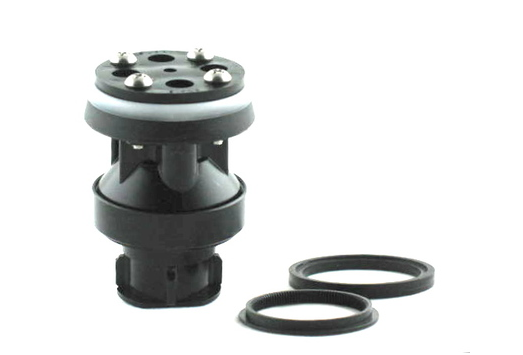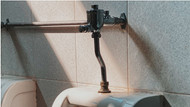Flushometer Pistons vs. Diaphragms: Is One Better Than the Other?
Mar 27th 2024
Neither flushometer pistons nor flushometer diaphragms are new technology. Both have been around for many years, yet there is still some debate among plumbing professionals whether or not one is superior to the other.
As in most aspects, there is no single hard answer. Rather, it comes down to operation and close consideration of the settings surrounding the operation. In some settings, flushometer pistons may be preferable to models that utilize a diaphragm, and vice versa.
Flushometer Basics
With all flushometers, pressurized water is delivered directly to the fixture from the supply pipes. It is the pressure of the water, specifically, that enables the efficient operation of a flushometer, whether it is a piston flushometer or a model with a diaphragm.
Both types of flushometers contain two chambers, an upper and a lower, sealed by a valve, and connected by a bypass, which is a very small hole. In a diaphragm flushometer, a flexible rubber disk (a diaphragm) separates the upper and lower chambers. In a piston flushometer, there is instead a molded cup.
How a Flushometer Piston Works

In a piston flushometer, the molded cup that separates the upper and lower chambers features a relief valve with a rubber lip seal that is held firmly in place on the inside of a hollow piston that contains a bypass, which separates the upper and lower chambers.
Pressing on the handle of the flushometer causes the internal plunger to displace the relief valve within the piston, which allows water to flow from the upper chamber. This changes the pressure acting on the relief valve.
This pressure change causes the molded cup to lift the piston, allowing water to flow under the piston from the inlet pipe. The lifting of the piston also allows the relief valve to reset; a little water flows through the bypass in the piston wall, equalizing the pressure, forcing the piston back down, and shutting off the water supply from the inlet.
How a Flushometer Diaphragm Works
In diaphragm flushometers, a flexible rubber diaphragm, which itself contains a bypass hole, separates the upper and lower chambers. In this model, supply water can travel through the bypass into the upper chamber, until the pressure of water about the diaphragm compresses it and a relief valve over the valve’s opening.
When a diaphragm flushometer is flushed, the plunger tilts the stem of the relief valve; this allows some water to travel down, around the diaphragm, through the valve. When water flows from the upper chamber, the pressure in the upper chamber drops, and the pressure in the lower chamber rises. When the pressure in the lower chamber rises, it forces the diaphragm up, allowing pressurized water to flow into the fixture from the inlet.
Then the relief valve and diaphragm reseat, and water begins to refill the upper chamber through the diaphragm’s bypass hole, repressurizing the upper chamber, forcing the diaphragm back down and closing off the entrance to the valve.
Should You Choose a Piston or a Diaphragm Model?
Just from this basic exposition on the operation of flushometer pistons and diaphragms, it might not be readily apparent if one or the other has any realistic, significant advantage over the other. To make an informed decision regarding upgrades or replacements, you need to take some additional factors into account.
One is traffic, or how many people use your restrooms and how frequently they use them. You can broadly categorize restroom traffic as either high or low.
Both piston and diaphragm flushometers are equally suited to handling low restroom traffic, since there will be plenty of time for the system to flush and reset before being flush again.
However, if you have a lot of restroom traffic, where a high volume of users are coming in and out of the bathroom, especially in rapid succession, a diaphragm model might be more suitable. These may be able to flush and resent more quickly, scaling with high volume.
Water quality can also be a concern when it comes to evaluating the relative strengths of flushometer pistons and diaphragms. Undesirable water quality can adversely affect the performance of a flushometer, corrode parts, cause bypass blockages, and more.
For example, pH and chemical concentration in the water are two of the biggest factors in terms of water quality. Highly acidic water (that is, water with a low pH) can break down rubber, such as those used for diaphragms, over time. Similarly, chlorine and chloramines can do the same. Thick diaphragms may be more suitable in environments where there is a high acid concentration or a large concentration of chloramines.

A high concentration of particulate matter or biomass in the water can also cause problems for flushometers, wearing sealing surfaces or building up in the bypass, slowing the operation of the flushometer or inhibiting it completely. A diaphragm, with its larger sealing surface area, may also get the nod for an advantage in these areas.
So what about flushometer pistons? Where are they preferable to diaphragm models? Well, piston models tend to perform better at low pressures than diaphragm flushometers do. Just remember that a flushometer model is designed to operate at a certain pressure level and volume. It’s not that piston flushometers are universally better at handling low pressure, this is just a general observation. Pistons may also be preferable in some weak systems where there tends to be some fluctuation (specifically dips) in water pressure.
The only way to be certain about your choice of flushometer infrastructure is to perform a close analysis of your setting and settings. That will help you evaluate whether or not you should proceed with piston flushometers or diaphragm flushometers - it’s not that one is better than the other. It’s the situation that dictates it.
Contact Us!
If you’d like some more insight into the specific operation of different flushometer types, don’t be afraid to reach out to us. You can also consult our experts on the relative advantages of either type or even for recommendations. Feel free to contact us and let us know how we can help you!

